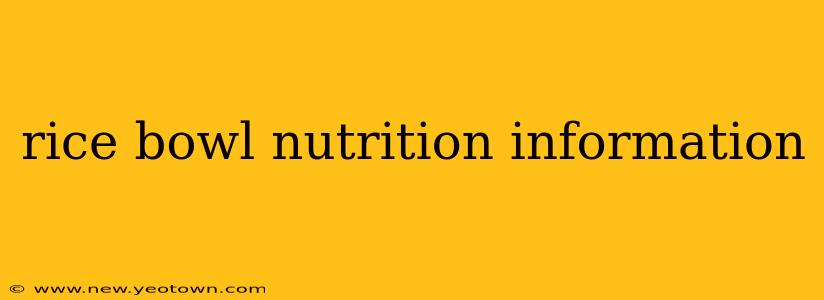The humble rice bowl. A culinary chameleon, it adapts to countless cuisines and preferences, from vibrant poke bowls bursting with fresh seafood to hearty Korean bibimbap brimming with vegetables and meat. But beyond its delicious versatility, lies a nutritional story worth exploring. This isn't just about simple carbs; understanding the nutritional makeup of your rice bowl can help you make informed choices and maximize its health benefits.
Let's embark on a journey to uncover the nutritional secrets hidden within this popular dish.
What are the main nutritional components of a rice bowl?
The nutritional profile of a rice bowl is incredibly diverse, depending heavily on its ingredients. However, we can identify some common components and their general nutritional contributions.
The base, typically rice (white or brown), provides carbohydrates – your body's primary energy source. Brown rice, in particular, offers added fiber, which aids digestion and promotes satiety. Then, there's the protein element, often sourced from lean meats like chicken or fish, tofu, beans, or lentils. These contribute essential amino acids for building and repairing tissues. Finally, vegetables form a crucial part of the equation, supplying vitamins, minerals, and antioxidants vital for overall health. Healthy fats, from sources like avocado, nuts, or seeds, can also feature, adding richness and essential fatty acids.
How many calories are in a typical rice bowl?
This is where things get tricky. A "typical" rice bowl is highly subjective! A small bowl of simple brown rice with steamed vegetables will have significantly fewer calories than a large bowl laden with fried meats, creamy sauces, and extra rice. Calories can range from a modest 300 to a hefty 1000 or more, depending on the ingredients and portion sizes. Paying attention to portion control and opting for nutrient-dense, lower-calorie ingredients is key.
What are the health benefits of eating a rice bowl?
A well-constructed rice bowl can be a nutritional powerhouse, offering a balanced mix of macronutrients and micronutrients. The benefits include:
- Sustained Energy: The carbohydrates provide sustained energy, ideal for fueling your day.
- Improved Digestion: Fiber-rich brown rice and vegetables promote healthy digestion.
- Muscle Building and Repair: Protein sources contribute to muscle growth and repair.
- Boosted Immunity: Vitamins and minerals from vegetables strengthen the immune system.
- Heart Health: Certain ingredients, like omega-3 fatty acids from fish or flaxseeds, can support heart health.
Is a rice bowl a healthy meal option?
The answer isn't a simple yes or no. A rice bowl can be a healthy and nutritious meal, but it all depends on the ingredients you choose. Opting for whole grains like brown rice, lean protein sources, and a generous helping of vegetables creates a balanced and wholesome meal. However, loading it up with processed meats, sugary sauces, and excessive amounts of rice can negate its health benefits, leading to a calorie-dense and less nutritious dish.
What are some healthy rice bowl recipes?
The beauty of the rice bowl lies in its adaptability. You can create countless healthy variations by experimenting with different ingredients. Consider incorporating:
- Base: Brown rice, quinoa, or cauliflower rice.
- Protein: Grilled chicken or fish, tofu, lentils, chickpeas.
- Vegetables: Broccoli, spinach, carrots, bell peppers, edamame.
- Healthy Fats: Avocado, nuts, seeds, olive oil.
By focusing on nutrient-rich ingredients and mindful portion control, you can transform your rice bowl into a delicious and healthy part of your diet. Remember, the key is balance and mindful choices.

